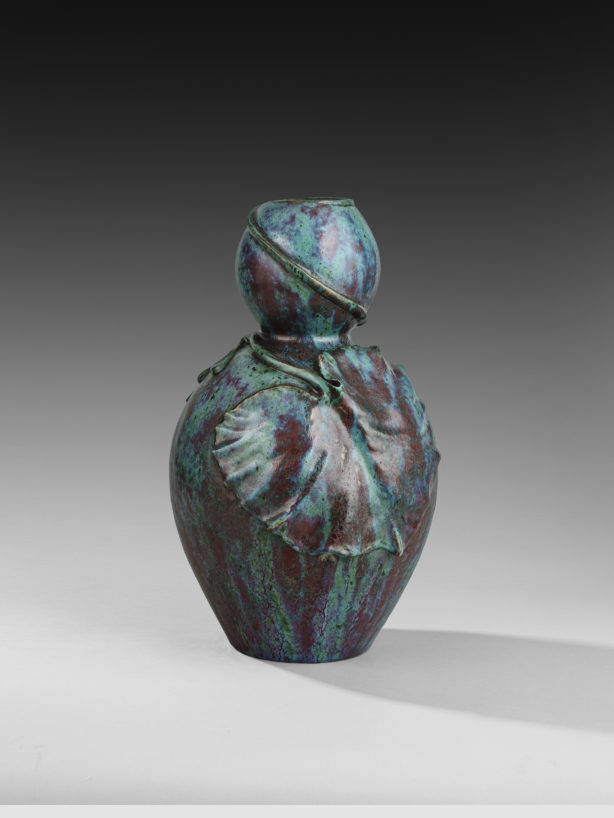Wild grapevine vase by Dalpayrat (1844-1910)
Of a model and size rare in Dalpayrat’s production, our vase, in “coloquinte” form and adorned with a wild vine bulb, is a veritable ode to nature.
If the first revelation of Japanese art to Parisian artists was the print, ceramics remains without doubt the other most fertile French enthusiasm, particularly for Dalpayrat. The Parisian collections he visited featured not only pots, but also masks, such as the one on display at the Musée de Sèvres as early as 1876. In 1878, once again for the Exposition Universelle the Japanese craze was revealed, notably for stoneware tea ceremony pieces, which encouraged Pierre-Adrien Dalpayrat to create pieces in plant and animal forms. From the 1890s onwards, ceramists and glassmakers created a new style, breaking with the past. Ceramics adopted organic, asymmetrical lines. Firing accidents, flame effects and glaze drips created abstract decorations that revolutionized the art of fire.
Oxblood red enamel is one of Pierre-Adrien Dalpayrat’s signatures, so much so that it is often referred to as “Dalpayrat red”. The ceramist, whose work on the border between Art Nouveau and Far Eastern ceramics made him famous, could boast of having unraveled the mystery of this fascinating color, mastered for centuries by the Chinese. In fact, he succeeded in obtaining this hue and these flamed effects on a very resistant stoneware, thanks to the oxidation of the copper and perfect control of the atmosphere and firing time. Beyond the red, shades of green or lead gray appear, adding depth to the piece. This invention was hailed several times, notably at the Exposition Universelle and the Salon de la Société nationale des beaux-arts, as well as at the Galerie Georges Petit.
Like the Symbolist painters and sculptors, Dalpayrat uses man, animal and nature in his compositions. He differs from many of his colleagues in his desire to give a simple vase a meaning, a symbol, a metaphysical idea, as evidenced by the vases and voids adorned with animals and plant motifs. Dalpayrat is fascinated by organic forms and the effect of time on living things. These physical consequences become his aesthetic preoccupation, whether in the form or surface of the objects he designs. His aim is to sublimate the fruits of nature, to show their intrinsic beauty by freezing them under an oxblood glaze dotted with yellow, blue or anthracite-gray spots.
Our vase is undoubtedly the fruit of a collaboration between Dalpayrat and another artist. After creating phantasmagorical vases with Alphonse Voisin-Delacroix, the ceramist collaborated with sculptor Jean Coulon and Maurice Dufrène (1876-1955). Whereas the glaze, covering the form with its drips, accidents and contrasts, had until then formed the main decorative element of Dalpayrat’s stoneware, Dufrène added curved lines and stylized foliage, adding movement and vitality to the objects. The glaze intrudes into the hollows formed by the relief of these new ornaments.
Production of the critically acclaimed artistic stoneware reached its peak in the late 1890s. Art critic Louis de Fourcaud praised the beauty of the works exhibited at the Salon each year in the Revue des arts décoratifs:
“M. Dalpayrat and Mme Lesbros exhibited together pots, vases, jugs where beautiful blues and purples form, with a red of rare intensity, like the tapers of unequal bangs or like jaspures where the vivid colors have mutually and splendidly splashed!”




